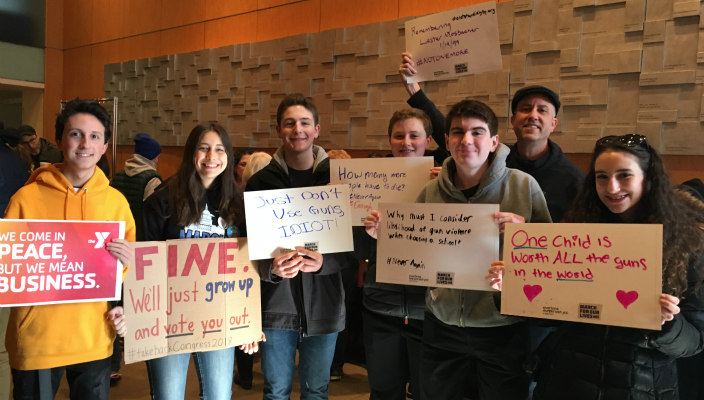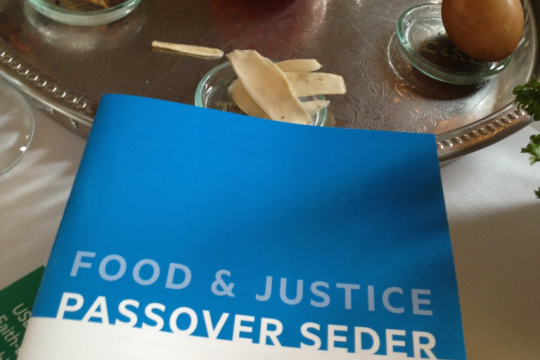
At the end of February, the week after the Parkland tragedy, Joel Mosbacher, Temple Shaaray Tefila’s senior rabbi, offered his space in the congregation’s weekly newsletter to Julia Feller, our youth group president. Julia wrote a moving, powerful message that said, in part:
[O]ne lunch period is not nearly enough time to understand and view [the gun violence] issue through every lens it deserves; therefore, the teens of Shaaray Tefila have decided to take matters to the synagogue, where gun violence is equally likely to affect us, and where we are allowed the time and space to explore and influence change.
Rabbi Mosbacher, a longtime, vocal gun safety advocate certainly could have put forward a powerful message of his own. Instead, he offered Ms. Feller a platform to speak to our entire congregation. The day before the March for Our Lives, the rabbi again offered our teens an opportunity to address the congregation, this time from the bimah during Friday night services, where their words inspired and motivated everyone who heard them.
Throughout the past month, we have witnessed powerful action around the issue of gun safety by youth leaders throughout the country – including in our own congregation. I am proud to be president of a synagogue that creates space for teens to lead. I’m also proud to be part of a culture in which leadership, while at once extraordinary, also does not feel new. Although I can’t take credit for the culture, I want to provide some context about what we do to help create an environment in which teens are empowered to lead and influence change.
In this moment, I see the fruits of a strong partnership among youth, clergy, professional staff, and lay leaders that is both structural and cultural. It starts with our full-time professional director of teen engagement, Andrew Paull, who, as a member of our leadership team, ensures that the interests of our youth are well represented within our programmatic decision-making structure. This structure enabled us to react nimbly and concertedly to the Parkland tragedy, and within days, our teens were organizing a Teen Gun Violence Prevention Task Force and planning a joint teen-adult forum on gun safety.
In an organization this large (we have more than 1,000 member households), it’s easy to imagine how such efforts might be siloed. That’s where our culture comes in. It takes many decisions and actors to create a culture; one visible expressions of ours is that we selected a teen leader to fill one of the 15 coveted spots on the search committee for our senior rabbi. This normalization of teen leadership makes it possible for a youth leader to address the entire congregation. It explains why it wasn’t a zeitgeist moment when our teens owned the teen-adult gun safety forum agenda. And it ensures that last Friday evening’s sermon felt natural within the context of our community.
Meaningful youth visibility is engrained in our culture. When we honor our congregation’s past and current presidents by inviting them to hold a Torah during Yom Kippur worship, we include our youth group president. It’s second nature to include our youth leaders’ sermons in our High Holiday Day sermon website links. As a result, Ms. Feller’s 2016 sermon “Taking Risks, Pursuing Justice” was the only non-clergy sermon included in the URJ’s High Holy Day sermon roundup that year.
And while we give our young people space to form their own thoughts and leadership styles, it is gratifying to see them internalize the values and tools provided by our curriculum. Like the adults in our community, our teens build agendas and lead meetings; they design worship services; they develop programming to engage other youth. They also are the co-creators of our high school electives program for eighth- through 12-graders. Now that they have formed a Teen Gun Violence Prevention Task Force, it is affirming to hear them acknowledge the “leadership tools we have grown in TaSTY [Shaaray Tefila’s youth group].”
From my vantage point, the building blocks of teen empowerment – a combination of resources, leadership opportunities, and visibility with smart, industrious and committed teens – all intersected this past month in an organic, seemingly effortless way. It’s a privilege to be a part of a community that elevates its teens in visible and meaningful ways, enabling them to lead, willingly, proudly, and confidently.
Have something to say about this post? Join the conversation in The Tent, the social network for congregational leaders of the Reform Movement. You can also tweet us or tell us how you feel on Facebook.
Related Posts

Passover 2024: The Three Central Messages of Pesach

Modern-Day Plagues of Injustice and Inequality
